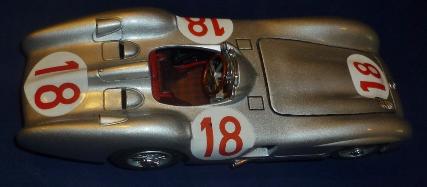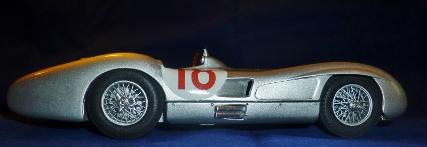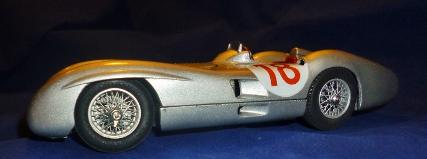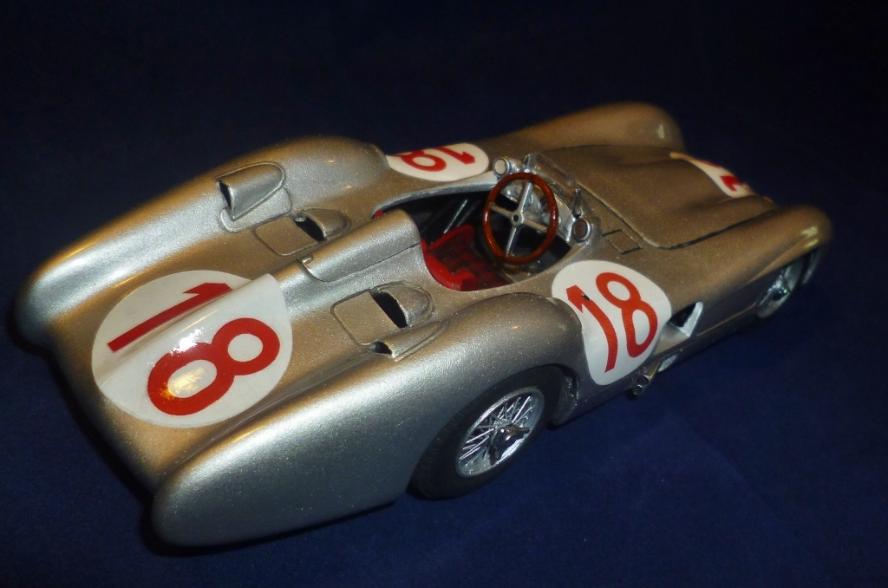
Mercedes-Benz W196 "Type Monza"
When the Mercedes W196 debuted for the 1954 French Grand Prix at the high-speed Reims-Gueux circuit they were in an all-enveloping aerodynamic body. Exploiting a loop hole in the regulations Mercedes hoped to gain valuable seconds by minimising drag, especially at high speed circuits. Rudolf Úhlenhaut and his talented group of engineers, Hans Scherenberg, Ludwig Kraus, Manfred Lorscheidt, Hans Gassmann, and Karl-Heinz Göschel, created a highly innovative chassis and engine which were well ahead of anything any other Grand Prix team had.
Although the enclosed bodywork proved to be a problem at twisty circuits as the drivers couldn’t see the wheels to accurately position the cars. At Silverstone even the great Juan Manuel Fangio damaged his car hitting the corner markers and Mercedes realised they would need an different body to help the drivers compete at places like Monaco where seeing the corners is vital.
Mercedes did use the stream lined bodywork again at the high-speed Monza circuit and from then on this style was christened the "Type Monza". In 1955 Mercedes once again used the aerodynamic bodies for the 26th Italian GP. Fangio had an new version of the body but Moss ran in one of the 1954 cars bodies.
1955 Italian GP
the Italian GP
held, as usual, at the Autodromo Nazionale Monza. The high speed banked circuit
hadn't been used since 1933 but new even steeper concrete curves had been built
over the earlier banking and the whole circuit renovated so that a combined
circuit of road track and high-speed oval could be combined to give a 10km
racing circuit that was a huge test of man and machine. One of the new corners
was the now famous "Parabolica" formed by the two corners of the
Curva Sud being re-profiled into one continuous bend.
With all the race cancellations, the XXVI Gran Premio d'Italia
became the 7th and final round of the driver’s championship. As Fangio had
already taken his second consecutive, and third in total, title the contest
wasn't perhaps as highly anticipated as it might have been. Ferrari had now
taken over the Lancia D50 programme after the withdrawal of Lancia from F1,
Fiat stepped in and bought the Lancia concern passing the D50s to Ferrari and
in effect saved Ferrari from the problems of the 555 supersqualo and made the
firm competitive again. Mercedes rolled out two of the streamliner cars for the
high-speed circuit as well as two open wheeled cars. Fangio #18 and Moss #16
had the streamliners while Kling #20 and Taruffi #14 drove the open wheeled
cars.
Practice saw Giuseppe Farina crash one of the Ferrari-Lancias in a huge accident caused by a tire failure on the new banking. Ferrari withdrew the two D50s of Farina, who wouldn't contest another F1 GP, and Villoresi and switched Castellotti to the older 555 alongside those of Trintignant, Hawthorn and Maglioli. Not that it was of any concern to Neubauer or Mercedes who controlled practice and filled the front row of the grid in the usual order of Fangio, Moss and Kling; Taruffi was 9th fastest. One can only wonder how the team felt knowing that the F1 team would be folded up at the end of the season and rumours that the Sportscar dream might also be ending starting to circulate.
In mild weather on the 11th of September 1955, the 50-lap race was started and Moss shot into the lead. Behind him were Fangio, Taruffi exploding from the fourth row of the grid, and Kling. When the field came around to conclude the first lap Fangio led the Mercedes train and little changed over the next few laps except for Kling muscling passed Taruffi. The laps counted down as cars flashed round the flat-out bends of the Villa Reale until Moss arrived in the pits on lap 19 to claim a replacement for his smashed windscreen. The change took just 39sec's but in an example of Neubauer's drive to maximize responses to any eventualities the next time Moss got in his Streamliner it had a new button on the dash'; it ejected the windscreen so it could be removed even more quickly and a replacement screen simply clipped into place. The change of screen hadn't been a big problem in itself but in charging to regain his place on Fangio's tail Moss' #16 streamliner broke its engine and put him out of the race, not before he set the fastest lap of the race at 2m46.9s though. Kling was having a good run in second place when his car's prop-shaft let go, although some accounts claim it was a gearbox issue that put him out of the race. This all left Neubauer holding out the RG “regulare” board to Fangio, and a surprised Piero Taruffi, indicating they should hold position and protect their cars to the finish.
Mercedes Last F1 GP for over 50 years was a 1-2 victory and closed a two-season run that had been easily as dominant a period as that of the 1930s. Castellotti brought home the Ferrari 555 in 3rd place but so far behind the Mercedes cars as to be almost in another race. Incidentally the driver’s championship was a Mercedes 1-2 as well, Fangio ahead of Moss, as it had been all season.
Today the Mercedes W196 F1 cars are incredibly valuable and highly desirable. On the 12th of July 2013 Mercedes-Benz W196R chassis number '00006/54' sold for a World Record price of £19.7-million Sterling, if that isn’t a high enough price then add on the VAT and charges and true cost to the purchaser was £20,896,800.00 Sterling.













This kit is a home-made special from a company called “CustomFX”. Ian purchased it at the Automodellismo model show around 2015 as a "2nds" quality kit as there are very few kits of the Mercedes stream lined F1 cars and none in 1/24th at the time. Ian finally plucked up courage to take on this challenge in 2017 and finished it in September of that year.
It certainly wasn’t an easy kit to build and Ian later found that it was really a copy of another companies diecast model. The wheels were poorly cast and Ian decided the best way to improve them was to cut out the whole centre of each wheel and replace the spokes with real wire ones. The internal chassis parts were replaced with ones made out of plastic rod and the body and other parts had to have a lot of fillers and work done to get them to an acceptable level and fitting together. Several parts inside the cockpit area had to be scratch built but in the end the car does look good.
Body colour is a silver from PlamoUK and their clear gloss covers the body to provide protection and a shine probably far above that which the real cars had at the time. AlcladII white aluminium was used for the interior and wheels and AlcladII Mil-spec tyre black was used for the tyres and proved to be a very good paint for none rubber tyres. Chrome for the three-pointed star and the aeroscreen frame is provided by the liquid chrome pens from Molotow. The exhausts were painted with AldcladII silver and covered with Bare Metal Foil to replicate the chromed look exhaust ends. Thinned down Humbrol matt black enamel paint was used as a wash to pick out the details and fill in the panel lines.
The decals were the finishing touch and we thank our good friend Richard Middleton for printing the roundels and numbers on his ALPS printer.
RETURN TO :-
